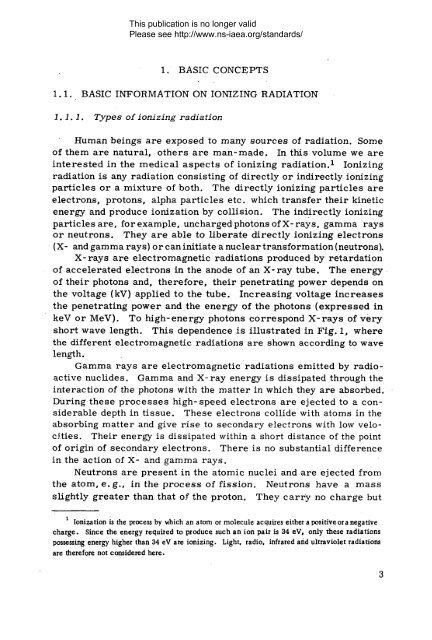Safety_Series_025_1968 - gnssn - International Atomic Energy ...
Safety_Series_025_1968 - gnssn - International Atomic Energy ...
Safety_Series_025_1968 - gnssn - International Atomic Energy ...
Create successful ePaper yourself
Turn your PDF publications into a flip-book with our unique Google optimized e-Paper software.
This publication is no longer validPlease see http://www.ns-iaea.org/standards/1. BASIC CONCEPTS1.1. BASIC INFORMATION ON IONIZING RADIATION1.1.1. Types of ionizing radiationHuman beings are exposed to many sources of radiation. Someof them are natural, others are man-made. In this volume we areinterested in the medical aspects of ionizing radiation.1 Ionizingradiation is any radiation consisting of directly or indirectly ionizingparticles or a mixture of both. The directly ionizing particles areelectrons, protons, alpha particles etc. which transfer their kineticenergy and produce ionization by collision. The indirectly ionizingparticles are, forexample, uncharged photons of X-rays, gamma raysor neutrons. They are able to liberate directly ionizing electrons(X- and gamma rays) or can initiate a nuclear transformation (neutrons).X-rays are electromagnetic radiations produced by retardationof accelerated electrons in the anode of an X-ray tube. The energyof their photons and, therefore, their penetrating power depends onthe voltage (kV) applied to the tube. Increasing voltage increasesthe penetrating power and the energy of the photons (expressed inkeV or MeV). To high-energy photons correspond X -rays of veryshort wave length. This dependence is illustrated in Fig. 1, wherethe different electromagnetic radiations are shown according to wavelength.Gamma rays are electromagnetic radiations emitted by radioactivenuclides. Gamma and X-ray energy is dissipated through theinteraction of the photons with the matter in which they are absorbed.During these processes high-speed electrons are ejected to a considerabledepth in tissue. These electrons collide with atoms in theabsorbing matter and give rise to secondary electrons with low velocities.Their energy is dissipated within a short distance of the pointof origin of secondary electrons. There is no substantial differencein the action of X- and gamma rays.Neutrons are present in the atomic nuclei and are ejected fromthe atom, e .g ., in the process of fission. Neutrons have a massslightly greater than that of the proton. They carry no charge but1 Ionization is the process by which an atom or m olecule acquires either a positive or a negativecharge. Since the energy required to produce such an ion pair is 34 eV, only these radiationspossessing energy higher than 34 eV are ionizing. Light, radio, infrared aiid ultraviolet radiationsare therefore not considered here.3
















